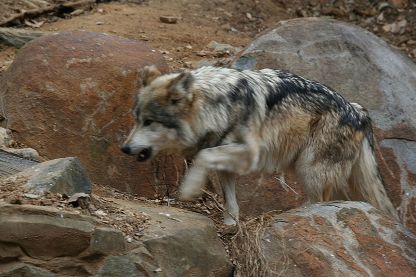Guest Column: Saving Animals Benefits Everyone
 “Each species is a masterpiece, a creation assembled with extreme care and genius.”
“Each species is a masterpiece, a creation assembled with extreme care and genius.”
You may never see a black-footed ferret. Or a Mexican gray wolf. Or a California condor.
But they are here because of state and national policies that value species diversity. Their existence is a credit to men and women who care.
Some of those people are scientists. The team that works with the endangered black-footed ferret breeding center at the Phoenix Zoo is a good example.
In the past 20 years, 399 ferrets were produced at the center. They contribute to a reintroduction effort that includes a ferret colony in Arizona’s Aubrey Valley near Kingman, where ferrets are now reproducing in the wild.
In the 1980s, there were only 18 black-footed ferrets in the world, none in Arizona.
Wildlife biologists at the Arizona Game and Fish Department and the U.S. Fish and Wildlife Service are also among those giving endangered animals a second chance.
And then there are the average Arizonans – urban and rural – who support those efforts because they understand the importance of biodiversity. Or maybe they just like knowing that somewhere in our rapidly urbanizing state, a wolf is howling at the night sky.
The efforts of all of these people matter for reasons that may not be immediately apparent.
For example, restoring predators to an ecosystem can improve habitat.
After wolves were reintroduced to Yellowstone National Park, the elk population was reduced, and the remaining elk moved around more and spent less time eating young aspen trees. This helped aspen trees make their own recovery, which helped other creatures that rely on aspens trees for food or shelter. This cascade of benefits strengthened the entire ecosystem.
Predators can also help humans directly.
In Arizona, the reintroduction of the endangered Mexican gray wolf continues to face vehement opposition from some ranchers. Wildlife biologists have responded to ranchers’ demands in ways that kept the wolf population far too small.
Nevertheless, the wolves are contributing to our state in unexpected ways. The White Mountain Apache Tribe made the lobos the centerpiece of eco-tours that also teach about the tribe’s culture.
Meanwhile, up at the Grand Canyon, efforts to reestablish a population of California condors continue. Three chicks hatched in the wild during this summer’s breeding season boosted the total number of condors on the planet to 396. In the 1980s, there were only 22. Arizona and Utah have a population of 67 condors out of the 196 condors now in the wild.
Look into the face of a child who sees one of those enormous birds soar over the Grand Canyon, and you’ll understand what people mean when they talk about the intrinsic value of wildlife. These birds have a magnificence that is worth preserving for its own sake.
Many plant and animal species in Arizona are threatened by extinction because of habitat destruction, disease, non-native species and climate change.
These precious native plants and animals have the hope of survival because of the continued support of people who appreciate the masterpiece each one represents.
*****************************************************************************
Please submit a letter to the editor thanking the AZ Republic for publishing this important guest column and expressing your support for Mexican gray wolf recovery and strong endangered species protections. This is especially important right now, when many in Congress are trying to weaken the Endangered Species Act and protections for wolves and other wildlife.
Letters can be submitted here.
Tips On Writing Letters
* Keep your letter to 200 words or less. The Republic won’t publish anything longer.
* Read the Paper’s Guidelines HERE.
* Be concise, make one or two points. Don’t attempt too much, there’s not enough space.
* Where you can, personalize the letter; tell a story. E.g. “I want my children to know that my generation stopped a second extinction of Mexican wolves in the wild.”
* Thank the newspaper. (Papers have egos, too) And this helps your letter get published.
* The Arizona Republic will publish letters from anyone in the state, regardless of city of residence.
* If you feel uncertain about your letter, we are happy to help. Send it to info@mexicanwolves.org
* Submit your letter here: Arizona Republic On-Line Submission.
* Be sure to send us a copy, so we can track what’s being published.
Sample Talking Points. These are only suggestions. PLEASE USE YOUR OWN LANGUAGE! We don’t want everybody sending the same words.
* Thank the Paper! E.g. “I agree with your Editorial, Saving Animals Benefits Everyone.”
* We have a moral, economic and scientific responsibility to protect species like the Mexican wolf for this, and future generations.
* Yet our extremist Congress recently attempted to pass an Extinction Rider that would have placed a moratorium on the protection of endangered species.
* Diverse, healthy species keep the land strong, the air fresh and our waters clean
* The Mexican Gray Wolf is a good example. With less than 50 individuals remaining in the wilds of Arizona and New Mexico, it is the most endangered wolf in the world.
* The current anti-environmental Congress must not be allowed to usher in a new era of extinction. I urge my Senators to stop any law that might weaken the endangered species act.
* The Endangered Species Act is the reason we still have magnificent creatures like the Mexican gray wolf.
For more editorial contacts and letter writing tips, click here.
You can read the column on the Arizona Republic website and post a comment here.
Photo courtesy of Moxfyre



